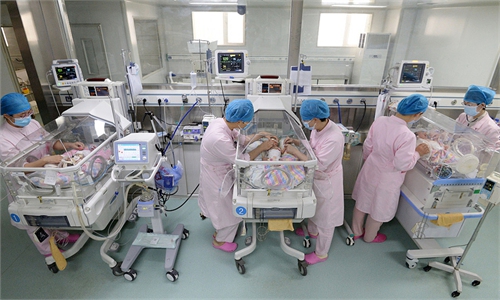First graders have class at Taipinglu Primary School in Haidian District, Beijing, capital of China, Aug. 29, 2020. (Photo: Xinhua)
By the end of 2022, the mainland population was 1.41175 billion, which includes the population of 31 provinces, autonomous regions and municipalities and servicemen, but excluding residents of Hong Kong, Macao and Taiwan regions and foreigners living in the mainland, a decrease of 850,000 over that at the end of 2021, the NBS announced on Tuesday.
It is the first time the country's population has recorded negative growth in 61 years since 1962.
"The data is not unexpected and conforms to the law of population development. Negative population growth is the inevitable result of the country's long-term low fertility rate," Yuan Xin, a professor from the Institute of Population and Development at Nankai University's School of Economics, told the Global Times on Tuesday.
Su Hainan, a research fellow from the China Association for Labor Studies, described it as "a natural result of social and economic development, which is similar to the population growth trajectories of Western countries in Europe, the US and Japan."
"The country's population saw a net increase of 480,000 in 2021 and a net decrease of 850,000 in 2022. The gap is very small for 1.4 billion people. So I believe the national population is still hovering around the zero growth stage," Yuan noted.
Cai Fang, former deputy director of the Chinese Academy of Social Sciences, believes that China's total population peaked in 2022, much earlier than expected, which means the country's population may maintain negative growth from 2023.
Yuan believes huge uncertainties lie ahead on whether population growth will rebound in future years.
Some people are choosing to delay pregnancy due to COVID-19 factors such as vaccination and viral infection, which may lead to a small baby boom after the epidemic stabilizes. After the introduction of the three-child policy in May 2021, local governments have boosted their efforts in terms of economic, time and service support, which will encourage some to have children when these policies take effect, Yuan said..
China announced a three-child policy in May 2021 and rolled out a series of stimulus measures to boost population growth. A number of cities, provinces and regions across the country have rolled out incentive policies such as issuing subsidies to families with a second or third child.
In 2022, the number of births was 9.56 million with a birth rate of 6.77 per thousand, marking the first time since 1950 that new births have fallen below 10 million and the third year the country's birth rate has fallen below 1 percent, data from the NBS showed.
Birth data for 2021 released by 31 provinces, autonomous regions and municipalities in the Chinese mainland showed that 13 provinces or regions had a negative population growth rate, and only six among the top 10 had birth numbers exceeding 500,000.
Demographic changes bring specific challenges to the economic and social system, yet at the same time provide new demographic opportunities, Yuan noted, dismissing voices claiming the country's demographic dividend has totally disappeared.
"The population size during the early stage of contraction will still be huge, which means the country will maintain its huge market. China's population began to fall in 2022, but the total population will still exceed 1.4 billion in 2035 and will still be above 1.3 billion in 2050," Yuan predicted.
The market brought by the country's sustained economic development, rising income level and strong consumption capacity will be immeasurable. It will provide a strong driving force for China's domestic economy cycle and lay a solid foundation for the realization of Chinese-style modernization, but also provide huge opportunities for the global economy, Yuan noted.
Observers suggest the country continue to establish policy systems to support fertility and create necessary conditions for reversing the dilemma of a low fertility rate, such as easing family burdens and releasing favorable policies to help women relieve their pressure at home, including flexible work schedules.
The NBS data showed that from the perspective of gender, the male population was 722.06 million, the female population was 689.69 million and the sex ratio of the total population is 104.69 men for every 100 women. In terms of age structure, the working-age population between 16 and 59 stood at 875.56 million, accounting for 62.0 percent of the national population, and the population aged 60 or above reached 280.04 million, accounting for 19.8 percent of the total, among which 209.78 million were aged 65 or above, accounting for 14.9 percent of the total population, the NBS revealed.
Compared with Western countries, China's aging population is growing much more quickly, and the trend of "getting old before getting rich" is obvious, observers said. To address problem of human resources brought by the aging population, Su suggested more efforts should be brought in to boost professional education, nurture professional talents and encourage those aged 60 and above to stay in the workforce.
In terms of the urban-rural structure, there were 920.71 million permanent residents in urban areas by the end of 2022, an increase of 6.46 million over the end of 2021 and 491.04 million permanent residents in rural areas, a decrease of 7.31 million. The share of the urban population among total population was 65.22 percent, 0.50 percentage points higher than that at the end of the previous year, NBS data showed.
NBS data also showed the country recorded 10.41 million deaths, equal to a mortality rate of 7.37 per thousand, with the overall natural population growth rate of minus 0.60 per thousand.
There were 270,000 more deaths recorded in 2022 than the previous year, an increase in the death rate of 0.19 per thousand than in 2021.
Official data showed in 2021 there were 10.41 million deaths, with a death rate of 7.18 per thousand.
China has conducted a nationwide population census every decade, with the latest carried out in 2020. In a non-nationwide census year like 2022, China runs a population sampling survey on November 1 each year, meaning the number of deaths for December is not available, an official from the NBS said.



